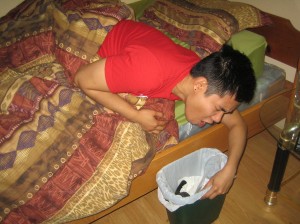It is important to note that the body utilizes fever to fight off infections such as viral or bacterial infections. When fever occurs, it has a functional role in the body but if it is too high, it poses as a health risk for a child. With this in mind, you should know how to take the temperature of the child properly and when to seek medical treatment so that the child is kept safe during a fever.
Methods in taking the temperature
There are different types of thermometers and techniques used in taking the temperature of a child. Each has minimal differences in the accuracy level and reading. The methods for taking the temperature include oral, axillary and rectal. There are special thermometers that will allow taking the temperature in other parts of the body including the forehead and the ears. The ear thermometers are not recommended for infants below six months since they are not always accurate.
A child has a fever if the temperature reaches 100 degrees F in the ear, temporal artery or rectum as well as orally. When the axillary method is used, a temperature that reaches 99 degrees F is considered as fever.

Range of fever
Once the temperature of the child reaches the minimum range to qualify as a fever, you have to monitor how high it increases to determine if medical care is required. The recommendations on the highest safe temperature tend to vary but a fever that is higher than 102 degrees F is enough to consult a doctor especially if it does not respond to fever-reducing medications.
There are ways to reduce the fever of the child by dressing him/her in light clothing, bathing in lukewarm water and keeping the room temperature cool. In case the fever continues to rise despite these measures, it is best to consult a doctor right away.
Age of the child
The age can affect the fever range and the need for medical care. In case the infant is six months old or younger, a doctor must be consulted at any sign of fever. From six months up to two years old, a doctor must be consulted if the fever lasts for 24 hours regardless how high it is. As for children over two years old, a doctor must be consulted if the fever lasts for 72 hours or more even if it is only a low-grade fever.
Other possible symptoms
In some cases, it is not the specific temperature but the accompanying symptoms that can determine the severity of the situation. If the child experiences other severe symptoms, a doctor must be consulted even if the temperature is not higher than 102 degrees F. The serious symptoms include vomiting, diarrhea, dehydration as well as recurring fever, changes in the eating habits, pain and rashes. If you want to learn how to manage these symptoms, click here.
You have to seek immediate medical care if the child suffers from symptoms such as bluish skin, lethargy, bulging or sunken soft spot as well as severe head pain, stiffness of the neck, difficulty breathing and limpness.
